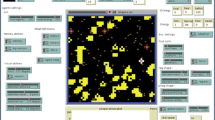Zusammenfassung
Ein Objekt-orientiertes Simulationsmodell wurde konstruiert, um in Verbindung mit Laboruntersuchungen einen Beitrag zur Kenntnis der Biologie der Raubmilbe Hypoaspis aculäfer zu leisten. Bei der Objektorientierten Simulation werden die Individuen als einzelne, unabhängig agierende Datenobjekte dargestellt, die qualitativ und quantitativ unterschieden werden können. Es wurde der Einfluß von verschiedenen Parametern, die die Aktivität der Individuen charakterisieren, auf die resultierende Populationsentwicklung untersucht. Die Durchführung sehr vieler Wiederholungsläufe der Simulation zeigt ferner, daß ein Bereich von Nicht-Vorhersagbarkeit ökologischer Entwicklungen auch bei präziser Kenntnis der Eigenschaften der einzelnen beteiligten Komponenten verbleibt.
Summary
In order to investigate the bionomics of the gamasid mite Hypoaspis aculäfer studies in the laboratory were conducted. Parallelly an object-orientated simulation model was constructed to explain the observed phenomena. By using an object-orientated modelling concept individuals are represented as single, independently acting data-objects, which can be qualitatively and quantitatively differentiated. Thereby the influence of parameters describing the activity of the individuals onto the resulting dynamics at the population level were investigated. Moreover the simulation of a large number of repetitons shows that concerning the population development a necessary range of unpredictability remains although the characteristics of all participating components are known.
Access this chapter
Tax calculation will be finalised at checkout
Purchases are for personal use only
Preview
Unable to display preview. Download preview PDF.
Similar content being viewed by others
References
BRECKLING, B. 1990 Singularität und Reproduzierbarkeit in der Modellierung ökologischer Systeme <Singularity and Reproducability in Modelling Ecological Systems> (in German) Dissertation Universität Bremen, FB 2
COLEMAN, D.C. 1986 The Role of microfloral and faunal interactions in affecting soil processes in: M.J. Mitchell, J.P. Nakas (Eds.) Microfloral and faunal interactions in natural and agroecosystems (p. 317 — 348) Martinus Nijhoff, Dr. W. Jungk Publishers (Dordrecht)
DAHL, O.J.; MYRHAUG, B.; NYGAARD, K. 1968 SIMULA. Common Base Language Oslo (Norwegian Computing Centre)
RUF, A. 1989 Die Populationsentwicklung der Raubmilbe Hypopaspis aculeifer (Canestrini 1883) Die Bedeutung von Arrhenotokie und Kannibalismus in Laborzuchten und deren Simulation im Computermodell. <Population Development of the Predatory Mite Hypoaspis aculeifer (Canestrini 1883) The Importance of Arrhenotoky and Cannibalism in Laboratory Cultures and their Simulation in a Computer Model; Diploma Thesis> (in German) Diplomarbeit im FB2 (Biologie/Chemie) der Universität Bremen
VISSER, S. 1985 Role of the soil invertebrates in determining the decomposition of soil microbial communities, in: A.H. Fitter (Ed.) Ecological interactions in soil: p. 297 — 317 Blackwell (Oxford)
Author information
Authors and Affiliations
Editor information
Editors and Affiliations
Rights and permissions
Copyright information
© 1991 Springer-Verlag Berlin Heidelberg
About this paper
Cite this paper
Breckling, B., Ruf, A., Mathes, K. (1991). An Object-Orientated Simulation Approach to Analyze the Bionomics of a Predatory Soil Mite. In: Möller, D.P.F., Richter, O. (eds) Analyse dynamischer Systeme in Medizin, Biologie und Ökologie. Informatik-Fachberichte, vol 275. Springer, Berlin, Heidelberg. https://doi.org/10.1007/978-3-642-77020-3_20
Download citation
DOI: https://doi.org/10.1007/978-3-642-77020-3_20
Publisher Name: Springer, Berlin, Heidelberg
Print ISBN: 978-3-540-54669-6
Online ISBN: 978-3-642-77020-3
eBook Packages: Springer Book Archive




